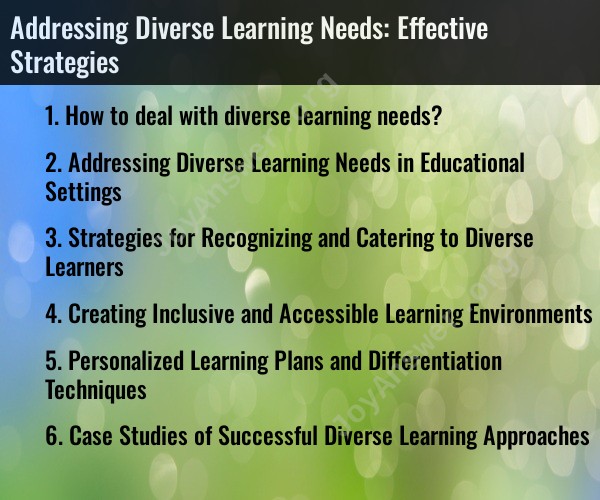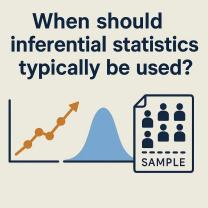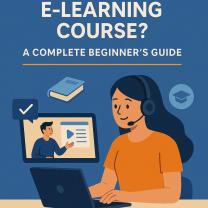How to deal with diverse learning needs?
Addressing diverse learning needs is a crucial aspect of effective teaching and training. People have different learning styles, abilities, and preferences, and it's essential to create an inclusive learning environment that accommodates these differences. Here are some strategies to deal with diverse learning needs:
Differentiated Instruction:
- Tailor your teaching methods to meet the individual needs of your learners. This might involve varying the content, process, or product of learning to accommodate differences in readiness, interests, and learning profiles.
- Use pre-assessments to determine students' prior knowledge and skills so you can adjust your teaching accordingly.
Universal Design for Learning (UDL):
- UDL is an educational framework that aims to make learning accessible to all by providing multiple means of engagement, representation, and expression. For instance, provide content in various formats (text, audio, video) and offer different ways for students to demonstrate their understanding.
Personalized Learning:
- Create personalized learning plans or pathways for students to help them focus on their specific needs, strengths, and interests.
- Use technology and adaptive learning tools to provide tailored content and assessments.
Collaborative Learning:
- Encourage collaboration among students. This allows them to learn from one another, share their strengths, and provide support to peers who may struggle in certain areas.
- Collaborative projects can promote teamwork and social learning.
Active Learning:
- Engage students in hands-on activities, discussions, and problem-solving exercises. Active learning methods can help students of different learning styles and abilities to participate and learn effectively.
Flexible Assessment:
- Provide a variety of assessment methods, such as written assignments, presentations, quizzes, or practical tasks, so that students can demonstrate their knowledge and skills in ways that suit them best.
- Offer opportunities for self-assessment and reflection.
Scaffolding:
- Provide additional support and guidance for learners who need it. This might involve breaking down complex tasks into smaller steps or offering extra resources.
Culturally Responsive Teaching:
- Be aware of the cultural backgrounds and experiences of your students. Incorporate diverse perspectives and materials that reflect their cultural identity, helping them feel more engaged and valued in the learning process.
Special Education Services:
- For students with specific learning disabilities or exceptional needs, work closely with special education professionals and support staff to provide individualized accommodations and support.
Regular Feedback and Reflection:
- Continuously gather feedback from your students to understand their needs and preferences. Adjust your teaching methods based on this feedback.
- Reflect on your teaching practices and be open to making changes to better address diverse learning needs.
Remember that effective teaching requires ongoing adaptation and responsiveness to your students' changing needs. By implementing these strategies and maintaining a learner-centered approach, you can create an inclusive and effective learning environment for all your students.
Addressing Diverse Learning Needs in Educational Settings
Diversity is a strength in educational settings, but it also presents challenges. Students come from a variety of backgrounds, cultures, and learning styles. To meet the needs of all learners, educators must be proactive and intentional in their teaching practices.
Here are some general strategies for addressing diverse learning needs in educational settings:
- Get to know your students. Take the time to learn about your students' individual strengths, weaknesses, and learning preferences. This will help you to tailor your instruction to their needs.
- Use a variety of teaching methods and materials. No single teaching method or material is effective for all learners. Use a variety of approaches to reach different types of learners.
- Provide differentiated instruction. Differentiate your instruction by providing students with different choices in how they learn, what they learn, and how they show what they have learned.
- Create a supportive and inclusive learning environment. Make sure that all students feel welcome and respected in your classroom. Encourage students to collaborate with and learn from each other.
Strategies for Recognizing and Catering to Diverse Learners
There are a number of ways to recognize and cater to diverse learners in educational settings. Here are a few strategies:
- Observe your students. Pay attention to how your students learn, interact, and respond to different teaching methods. This will help you to identify students who may need additional support.
- Use assessments. Assessments can help you to identify students' strengths and weaknesses. You can use this information to develop personalized learning plans for your students.
- Talk to your students. Ask your students about their learning preferences and needs. This information will help you to plan your instruction and provide the support that your students need.
Creating Inclusive and Accessible Learning Environments
An inclusive and accessible learning environment is one in which all students feel welcome and supported. Here are some strategies for creating an inclusive and accessible learning environment:
- Use universal design for learning (UDL). UDL is a framework for designing learning environments and materials that are accessible to all learners. UDL principles include providing multiple means of representation, engagement, and action and expression.
- Provide accommodations and modifications. Accommodations and modifications are changes to the learning environment or instruction that can help students with disabilities access and learn the curriculum.
- Promote positive peer relationships. Encourage students to collaborate and learn from each other. Create opportunities for students to interact with students from different backgrounds and cultures.
Personalized Learning Plans and Differentiation Techniques
A personalized learning plan (PLP) is a document that outlines a student's individual learning goals and the steps that will be taken to achieve those goals. PLPs can be used to differentiate instruction for diverse learners.
Here are some differentiation techniques that you can use to create personalized learning plans for your students:
- Provide students with choices in how they learn. Allow students to choose from a variety of activities and assignments.
- Provide students with choices in what they learn. Offer students a variety of topics and themes to choose from.
- Provide students with choices in how they show what they have learned. Allow students to demonstrate their learning in a variety of ways, such as through projects, presentations, and essays.
Case Studies of Successful Diverse Learning Approaches
There are a number of successful diverse learning approaches that have been implemented in educational settings. Here are a few case studies:
- The New York City Department of Education's Universal Pre-K program. This program provides high-quality early childhood education to all children, regardless of their background or income. The program has been shown to improve children's academic and social-emotional outcomes.
- The Boston Public Schools' English Language Learner program. This program provides support to English language learners (ELLs) so that they can succeed in school. The program offers ELLs instruction in their native language, as well as English language instruction. ELLs in the program have shown strong academic growth.
- The High Tech High charter school network. This network of schools offers students a rigorous and project-based learning experience. High Tech High schools have a diverse student population, and they have been successful in preparing students for college and careers.
These are just a few examples of successful diverse learning approaches. There are many other ways to meet the needs of all learners in educational settings.













